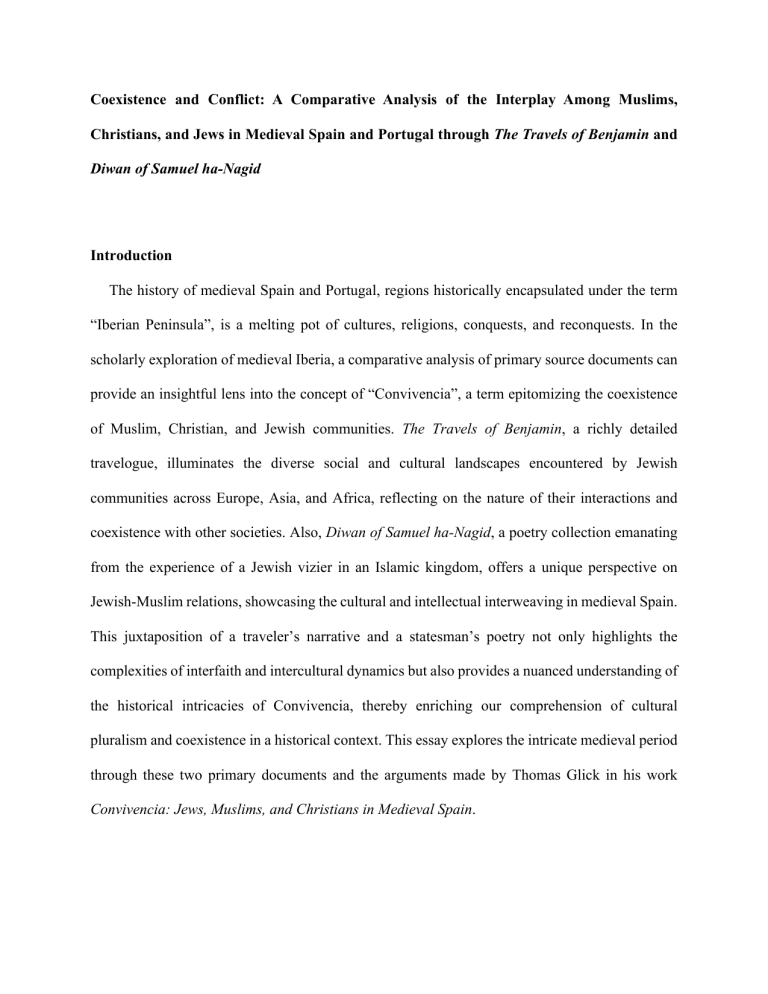
Coexistence and Conflict: A Comparative Analysis of the Interplay Among Muslims, Christians, and Jews in Medieval Spain and Portugal through The Travels of Benjamin and Diwan of Samuel ha-Nagid Introduction The history of medieval Spain and Portugal, regions historically encapsulated under the term “Iberian Peninsula”, is a melting pot of cultures, religions, conquests, and reconquests. In the scholarly exploration of medieval Iberia, a comparative analysis of primary source documents can provide an insightful lens into the concept of “Convivencia”, a term epitomizing the coexistence of Muslim, Christian, and Jewish communities. The Travels of Benjamin, a richly detailed travelogue, illuminates the diverse social and cultural landscapes encountered by Jewish communities across Europe, Asia, and Africa, reflecting on the nature of their interactions and coexistence with other societies. Also, Diwan of Samuel ha-Nagid, a poetry collection emanating from the experience of a Jewish vizier in an Islamic kingdom, offers a unique perspective on Jewish-Muslim relations, showcasing the cultural and intellectual interweaving in medieval Spain. This juxtaposition of a traveler’s narrative and a statesman’s poetry not only highlights the complexities of interfaith and intercultural dynamics but also provides a nuanced understanding of the historical intricacies of Convivencia, thereby enriching our comprehension of cultural pluralism and coexistence in a historical context. This essay explores the intricate medieval period through these two primary documents and the arguments made by Thomas Glick in his work Convivencia: Jews, Muslims, and Christians in Medieval Spain. Authorship and Audience The Travels of Benjamin, known officially as The Itinerary of Benjamin of Tudela, is a remarkable primary document authored by Benjamin of Tudela, a Jewish traveler and explorer from the town of Tudela in Navarre. This text, written approximately between 1160 and 1173 AD, is a travel narrative that chronicles Benjamin’s extensive journeys through various parts of Europe, Asia, and Africa. While the exact location of its compilation is uncertain, it is presumed that Benjamin penned his observations either in his hometown of Tudela or upon his return from his travels. Its intended audience was primarily the Jewish community, aiming to inform and connect Jews of different regions about their counterparts in distant lands. However, its rich descriptions of geography, culture, and religion extend its appeal and importance to a broader scholarly audience interested in medieval history. On the other hand, Diwan of Samuel ha-Nagid, presents a different perspective of Jewish life in the medieval period. Samuel ha-Nagid, also known as Samuel Ibn Naghrela, was a notable Jewish figure in the Islamic world, particularly in the kingdom of Granada where he served as a vizier and military commander during the 11th century. The “Diwan” is a collection of his poetry, written predominantly in the first half of the 11th century in Granada, Spain. This compilation not only showcases Samuel ha-Nagid’s literary prowess but also reflects his unique position as a Jewish scholar and high-ranking official in a Muslim kingdom. The audience for this work was likely both the Jewish community and the broader intellectual circles of Andalusia and it reflects the interconnectedness of Islamic and Jewish intellectual traditions at the time. The Diwan, therefore, is a significant historical document that illuminates the cultural, intellectual, and political landscape of Jewish life under Islamic rule in medieval Spain. Insights into Idea of Salvation The concept of salvation, as reflected in The Travels of Benjamin and the Diwan of Samuel haNagid, offers a nuanced perspective when examined through the lenses of their respective contents and contexts. While neither text explicitly focuses on theological discussions about salvation, their narratives and themes can be interpreted to provide insights into aspects of spiritual and communal salvation within the Jewish tradition. In The Travels of Benjamin, Benjamin of Tudela embarks on a journey documenting the conditions, customs, and lifestyles of Jewish communities across various regions. His detailed accounts, while primarily geographical and social in nature, indirectly touch upon the idea of communal salvation. This form of salvation is seen in the preservation and continuity of Jewish life and traditions amidst diverse and often challenging environments. For example, Benjamin’s descriptions of prosperous Jewish communities engaging in trade, maintaining synagogues, and thriving culturally in places like Constantinople and Baghdad can be seen as testaments to the resilience and survival of Jewish traditions. These accounts highlight how these communities found ways to sustain their religious and cultural identity, which can be viewed as a form of collective salvation in maintaining their faith and practices across the diaspora. The Diwan of Samuel ha-Nagid, on the other hand, presents a more personal, explicit reflection that can be associated with spiritual salvation. His poetic expressions of devotion, ethical conduct, and philosophical contemplation suggest an underlying search for spiritual understanding and fulfillment. In the context of Jewish theology and philosophy, these themes can be related to the pursuit of spiritual salvation – an individual’s journey towards understanding, righteousness, and alignment with religious principles. More importantly, he also poeticizes the idea of salvation directly in sentences. For example, he employs many repetitions of imperative, like “Shake off, Shake off ( ִה ְת ַנ ֲﬠ ִר י, ”)ִה ְת ַנ ֲﬠ ִר יand “Awake, awake ( עוּ ִר י,( ”)עוּ ִר י105, Sassoon), to imitate the tone of the Lord, or a prophet of consolation speaking in his name, proclaiming that salvation has come. He also composes emotionally resonant sentences like “upon your holy height build me like a tower, and upon your heart set me as a seal ( ַﬠ ל ְמ רוֹ ם ָק, ַו ֲﬠ ֵל י ִל ְבּ ך ְכּ ִמ ְג ָדּ ל ְבּ ֵנ ִני,ְכּ חוֹ ָת ם ְתּ ֵנ ִני ( ”)ְד שְׁ◌ ך112, Sassoon) to instill faith in people. Through these perspectives, both The Travels of Benjamin and the Diwan of Samuel ha-Nagid, albeit in different ways, contribute to the understanding of salvation from a Jewish viewpoint. Indeed, the themes of belonging and salvation are also emphasized by Glick, as he articulates that “the policy of forced conversion was not particularly effective” and “whatever the reasons had been for the forced conversion and whatever the Jew’s reactions might have been, the ‘baptized and unbaptized’ Jews had not been successfully integrated into Christian society” (14, Glick). All of these works highlight the communal aspect of preserving Jewish identity and traditions, and the individual pursuit of spiritual understanding and ethical living. These narratives offer a glimpse into how medieval Jewish communities and leaders navigated their faith and identity in diverse cultural and religious landscapes, providing a broader sense of spiritual and communal resilience. Significance of Cultural Permeation via Convivencia The themes of cultural interactions and Convivencia, as illustrated in The Travels of Benjamin and the Diwan of Samuel ha-Nagid, provide a rich narrative of the coexistence and interplay between Jewish, Christian, and Muslim communities during the medieval period. These primary documents, each in their unique way, shed light on the complexities and nuances of intercultural relations in a time when religious and ethnic boundaries were both distinct and permeable. In The Travels of Benjamin, Benjamin of Tudela provides a vivid account of the Jewish communities he encounters, along with their interactions with Christian and Muslim societies. One notable example is his description of the Jewish community in Constantinople, which was flourishing under the Byzantine Empire. Benjamin notes the respect accorded to Jewish scholars and mentions the freedom with which Jews practiced their religion, engaged in trade, and contributed to the economic life of the city. This account reflects a degree of tolerance and integration, indicating a form of Convivencia where different communities coexisted and interacted beneficially. Another example from Benjamin’s travels is his depiction of the Jewish community in Baghdad, which was under Islamic rule at the time. He describes Baghdad as a “center of learning and culture” (102, Simon), where Jews, Christians, and Muslims coexisted. The Jewish community, in particular, was noted for its scholars and the renowned rabbi and physician Rabbi Benjamin. This example underscores the intellectual exchanges and mutual respect that could exist between different religious communities. The Diwan of Samuel ha-Nagid presents a different aspect of Convivencia. Samuel ha-Nagid’s life and work in Granada, where he served as a vizier in a Muslim kingdom, exemplify the potential for collaboration and mutual respect between Jews and Muslims. His poetry often reflects a harmonious blend of Hebrew and Arabic influences that showcase the cultural and intellectual symbiosis of the period (for instance, “Time is on my side, I rejoice within my tent; My redeemer has come, my mourning days are over ( ֵה ִצ יץ ְו ִה שְׁ◌ ִגּ יַח ִמ ן ַה ֲח ַר ִכּ ים ַא ֲח ֵר י ָכ ְת ִל י,ָבּ א גוֹ ֲא ִל י.)” (113, Sassoon) shows the joy of love and integration). Samuel’s unique position as a Jewish leader in a Muslim society highlights the permeability of religious and cultural boundaries and the possibility of Jews attaining high status and influence in a predominantly Muslim context. Moreover, Samuel ha-Nagid’s role in the court of Granada, where he was involved in governance and military leadership, illustrates a remarkable instance of trust and collaboration across religious lines. His contributions to the administration and his patronage of arts and learning in Granada signify a period where religious identity was not a barrier to public service and cultural contribution. These examples from The Travels of Benjamin and the Diwan of Samuel ha-Nagid demonstrate the varied nature of Convivencia in medieval Iberia and beyond. They reveal a complex tapestry of relations where Jewish, Christian, and Muslim communities sometimes lived in harmony and mutual enrichment, despite the challenges and conflicts of their time. Such idea also aligns with the arguments by Glick. Although there are limits of cooperation between Jews and the dominant monotheistic cultures of the Middle Ages, the exchange of cultural elements “did not merely include vocabulary, techniques, or manners of speech, dress, or diet” but involved with conscious shifts of the “most subtle and intimate nature” (5, Glick). These narratives challenge simplistic views of the medieval period as a time of constant religious strife. Instead, they offer a more nuanced picture of intercultural coexistence and interaction. Conclusion In conclusion, the comparative analysis of The Travels of Benjamin and the Diwan of Samuel ha-Nagid illuminates the diverse experiences of the medieval Jewish Diaspora and the intricate dynamics of Convivencia. Benjamin’s detailed accounts of his travels offer a window into the varied lives of Jewish communities across Europe, Asia, and Africa and showcase their resilience and adaptability amidst different cultural and religious landscapes. On the other hand, Samuel haNagid’s poetic reflections provide an introspective view of Jewish-Muslim relations in Andalusia, highlighting a period of intellectual and cultural symbiosis. Together with the arguments made by Glick, these works not only deepen our understanding of Jewish history in the medieval period but also resonate with contemporary themes of multicultural coexistence, tolerance, and the complexity of cultural identity. Bibliography • Mann, Vivian B., Thomas F. Glick, and Jerrilynn D. Dodds, editors. Convivencia: Jews, Muslims, Christians in Medieval Spain. George Braziller, New York, 1992. • Benjamin of Tudela. The Itinerary of Benjamin of Tudela. J. Simon, 1983. • Samuel ha-Nagid, and Sassoon, Solomon David. Diwan of Samuel ha-Nagid. Oxford University Press, London, 1934.



